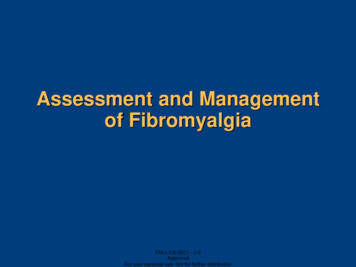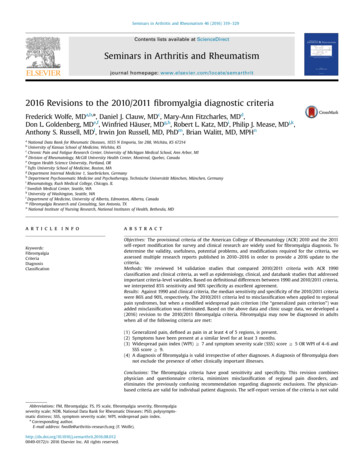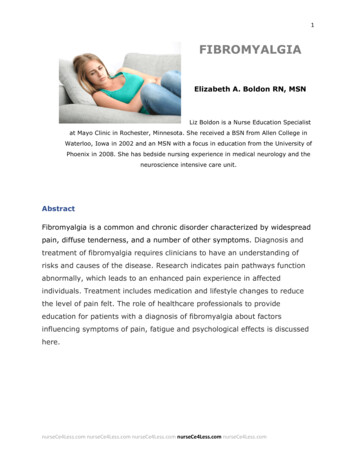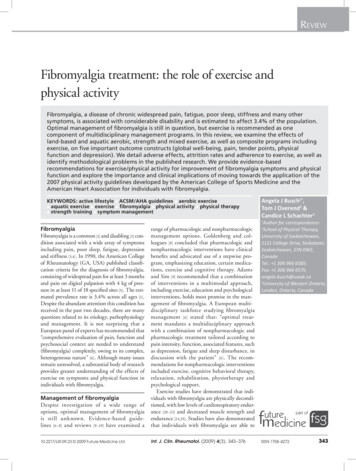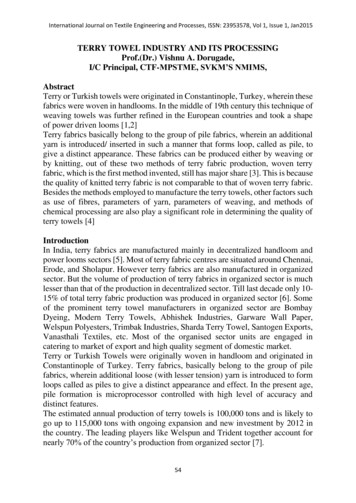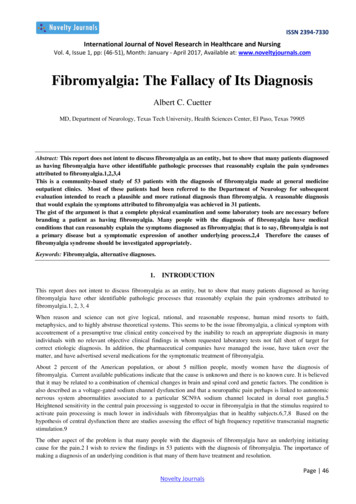
Transcription
ISSN 2394-7330International Journal of Novel Research in Healthcare and NursingVol. 4, Issue 1, pp: (46-51), Month: January - April 2017, Available at: www.noveltyjournals.comFibromyalgia: The Fallacy of Its DiagnosisAlbert C. CuetterMD, Department of Neurology, Texas Tech University, Health Sciences Center, El Paso, Texas 79905Abstract: This report does not intent to discuss fibromyalgia as an entity, but to show that many patients diagnosedas having fibromyalgia have other identifiable pathologic processes that reasonably explain the pain syndromesattributed to fibromyalgia.1,2,3,4This is a community-based study of 53 patients with the diagnosis of fibromyalgia made at general medicineoutpatient clinics. Most of these patients had been referred to the Department of Neurology for subsequentevaluation intended to reach a plausible and more rational diagnosis than fibromyalgia. A reasonable diagnosisthat would explain the symptoms attributed to fibromyalgia was achieved in 31 patients.The gist of the argument is that a complete physical examination and some laboratory tools are necessary beforebranding a patient as having fibromyalgia. Many people with the diagnosis of fibromyalgia have medicalconditions that can reasonably explain the symptoms diagnosed as fibromyalgia; that is to say, fibromyalgia is nota primary disease but a symptomatic expression of another underlying process.2,4 Therefore the causes offibromyalgia syndrome should be investigated appropriately.Keywords: Fibromyalgia, alternative diagnoses.1.INTRODUCTIONThis report does not intent to discuss fibromyalgia as an entity, but to show that many patients diagnosed as havingfibromyalgia have other identifiable pathologic processes that reasonably explain the pain syndromes attributed tofibromyalgia.1, 2, 3, 4When reason and science can not give logical, rational, and reasonable response, human mind resorts to faith,metaphysics, and to highly abstruse theoretical systems. This seems to be the issue fibromyalgia, a clinical symptom withaccoutrement of a presumptive true clinical entity conceived by the inability to reach an appropriate diagnosis in manyindividuals with no relevant objective clinical findings in whom requested laboratory tests not fall short of target forcorrect etiologic diagnosis. In addition, the pharmaceutical companies have managed the issue, have taken over thematter, and have advertised several medications for the symptomatic treatment of fibromyalgia.About 2 percent of the American population, or about 5 million people, mostly women have the diagnosis offibromyalgia. Current available publications indicate that the cause is unknown and there is no known cure. It is believedthat it may be related to a combination of chemical changes in brain and spinal cord and genetic factors. The condition isalso described as a voltage-gated sodium channel dysfunction and that a neuropathic pain perhaps is linked to autonomicnervous system abnormalities associated to a particular SCN9A sodium channel located in dorsal root ganglia.5Heightened sensitivity in the central pain processing is suggested to occur in fibromyalgia in that the stimulus required toactivate pain processing is much lower in individuals with fibromyalgias that in healthy subjects.6,7,8 Based on thehypothesis of central dysfunction there are studies assessing the effect of high frequency repetitive transcranial magneticstimulation.9The other aspect of the problem is that many people with the diagnosis of fibromyalgia have an underlying initiatingcause for the pain.2 I wish to review the findings in 53 patients with the diagnosis of fibromyalgia. The importance ofmaking a diagnosis of an underlying condition is that many of them have treatment and resolution.Page 46Novelty Journals
ISSN 2394-7330International Journal of Novel Research in Healthcare and NursingVol. 4, Issue 1, pp: (46-51), Month: January - April 2017, Available at: www.noveltyjournals.com2. METHODSThis is a community-based study of 53 patients in a period of 10 years, with the diagnosis of fibromyalgia made atgeneral medicine outpatient clinics. Most of these patients had been referred to the Department of Neurology forsubsequent evaluation intended to reach a plausible and more rational diagnosis than fibromyalgia.3. RESULTSPatient Population:A reasonable diagnosis that would explain the symptoms attributed to fibromyalgia was achieved in 31 patients. The gistof the argument is that a complete physical examination and some laboratory tools are necessary before branding a patientas having fibromyalgia.The following list includes those chronic medical conditions that were present in individuals with the clinical diagnosis offibromyalgia.1. Neuromyelitis optica (NMO) with myeloradiculopathies:Three patients referred to Neurology for electrodiagnostic studies gave one to two year-history of constant severeparaspinal pain and pain and spams of upper and lower extremities. Their ages ranged from 24 to 26 years. Two werefemale, and one was male. Previous rheumatologic work up had been negative and they had the diagnosis of fibromyalgiaand were taken gabapentin, or pregabalin, and duloxetine. Examination showed no specific motor deficit and one hadhyperactive muscle stretch reflexes but no pathologic reflex. No bladder problem. No gait problem or incoordination.MRI of brain was normal. All had more than one segment intra- axial demyelinating lesions in the cervicothoracic cord.One had oligoclonal banding on cerebrospinal fluid. Two patients were sero positive for NMO-IgG antibodies against theaquaporin 4 antigen. A seronegative patient developed left optic neuritis. All these three patients had neuromyelitisoptica. The paraspinal pains and extremity pains are explained by irritating effect of demyelinating plaques at the entryzones of the dorsal roots in the cord.102. Multiple sclerosis (MS) plaques at the entry zone of cervical and thoracic sensory nerves:A 32-year-old woman gave a history of bilateral shoulder and interscapular pain. She was taking medications for thediagnosis of fibromyalgia. She had hyperactive MSR, multiple sensory levels to pinprick up to cervical cord and bilateralHoffmann signs, but no Babinski sign. MRI of the brain and cervical spine showed a diffuse demyelinating process.Cerebrospinal fluid had 7 oligoclonal banding more than in the serum. Visual evoked responses showed delayed P100waves. The diagnosis was relapsing remitting multiple sclerosis.3. Cervical spondylosis with multilevel cervical radiculopathies and myelopathy:Twelve patients had constant periscapular pains, shoulder pains, neck pain and pain in the arms and forearms. Their agesrange from 56 to 82 years. Six of these patients had multilevel spondylotic changes, but they and the other six patientswere being treated for fibromyalgias. Cervical spine MRIs, somatosensory evoked responses in two patients, and needleelectromyography indicated the correct diagnosis of multiple cervical radiculopathies.An illustrative case is a 76 year-old male physician with significant constant paraspinal and thoracic pain worse in themorning; and pain in both shoulders and upper extremities. At different times since age 56 he suffered recurrent cervicalradiculopathies at different level and in both sides. These radiculopathies were punctuated by traumatic events in whichhe had suffered axial injuries to cervical areas. At one time a rheumatologist suggested that the pain was due tofibromyalgia and recommended gabapentin. Examination showed atrophy of the interosseous and thenar eminencemuscles of the right hand (C8-T1), atrophy of the right anconeus, pronator teres and flexor carpi radialis muscles. TheMSRs were hyperactive below the C7 level, and there was frequency and urgency in urination. MRI of cervical spineshowed old compressive fractures of C7 and T1, significant canal stenosis and multilevel spondylosis. Somatosensoryevoked responses were consisted with cervical radiculopathies.4. Thoracolumbar spondylosis, lumbosacral radiculopathies and stenosis of the lumbar spinal canal:There were 8 patients with the diagnosis of fibromyalgia who had multi-level paraspinal radiculopathies of the dorsalmixed sensory-motor rami of the spinal nerves. Needle electromyography showed widespread denervation of thePage 47Novelty Journals
ISSN 2394-7330International Journal of Novel Research in Healthcare and NursingVol. 4, Issue 1, pp: (46-51), Month: January - April 2017, Available at: www.noveltyjournals.comparaspinal thoracolumbar segments. Duloxetine and either gabapentin or pregabalin had been effective for this type ofneuropathic pain. There were 2 patients with the diagnosis of fibromyalgia who complained of pains in the trunk, lowback pain and cramps in both legs. In both cases MRI of the lumbar spine showed severe spinal stenosis at L3-L4 and L4L5. Epidural blocks help from 1 to 2 months in both cases. They have been discussing surgical interventions withneurosurgeons.5. Chronic inflammatory demyelinating neuropathy:A 56-year-old man had pain in the trunk and in the back. A rheumatologic work up was negative. He was seen by aneurologist at the neurology clinic who found mild muscular weakness, distal sensory deficit to pinprick and absentmuscle stretch reflex. Nerve conduction studies showed prolonged latencies, temporal dispersion of compound muscleaction potentials, and slow nerve conduction studies ranging from 29 to 32 meters per second. Sensory nerve conductionstudies showed absence response or prolonged latencies. F waves (proximal conduction) were prolonged. Needleelectromyography showed paucity of fibrillations and a drop out of motor unit action potentials. These findings wereindicative of a chronic diffuse demyelinating polyneuropathy. He received intravenous immunoglobulin at 400mg/kilo/day for 5 days. Slight improvement was noted after repeating treatment every 3 months. The diagnosis waschronic inflammatory demyelinating polyneuropathy. Another patient with paraspinal and extremity muscle pain andparesthesias in the feet was found on electrodiagnostic studies to have a demyelinating neuropathy. She responded tointravenous immunoglobulin.6. Bilateral cerebral infarcts: A 52-year old woman had constant cervical and thoracolumbar paraspinal pains:Four years prior to the presentation she suffered recurrent ischemic cerebral infarcts with consequent residual upper motorneuron weakness in both sides of the body and a spastic gait. Extensive evaluation showed that she had antiphospholipidantibody syndrome; and on MRI she had multiple high intensity signals in the cerebrum. She had received daily physicaltherapy and gait training. The muscle pain in paraspinal muscles and shoulder and pelvis girdle muscles appeared to havebeen a result of gait imbalance with unequal vectors and consequent unequal resultant of force reeling the body to oneside; and as a consequence, the patient would compensate by tilting her body to the other side to prevent falling.7. Myopathy:Myopathy was associated with the concomitant use of statin and gemfibrozil. One patient with myalgias takinggemfibrozil and statin was referred to Neurology for electrodiagnostic studies. CK was elevated and needleelectromyography showed early full recruitment of short duration abundant small polyphasic potentials compatible withmyopathy in some muscles.8. Giant cell arteritides:An 81-year-old woman mother of an intensive care unit nurse. Her daughter brought her to clinic because she wasconcerned about her mother constant neck and shoulder pain and headaches and the nurse thought that her mother couldhave something different from the fibromyalgia for which she was being treated. No acute visual symptoms. She hadnothing significant on neuroimaging of brain and cervical spine. She had abnormal electrocardiographic changes ofcardiac ischemia. The sedimentation rate was 59. Temporal artery biopsy was positive for temporal arteritides. Theshoulder myalgias were explained by arteritis of the occipital arteries. Her myalgia pains significantly improved onsteroids.4. DISCUSSIONMany patients with neuropathic and non-neuropathic pains of different causes and locations suffer from an amplificationof pain process that leads to diffuse pain, allodynia and a chronic dysfunctional pain syndrome. There is a hard core oforganicity that generates pain. The hard core is not always “fibromyalgia” as a disease entity, but instead a symptom ofanother condition. This hard core can be due to multilevel chronic radiculopathies, or irritation of the dorsal roots byspinal stenosis, myeloradiculitis like in NMO, and MS, peripheral neuropathy, muscle ischemia like in giant cellarteritides, and myositis. The problem is more complex when in addition to myalgias there is a clinical consolidatedcollection of diagnoses that may include muscle tension headache, major depressive disorder, constant low back pain,Page 48Novelty Journals
ISSN 2394-7330International Journal of Novel Research in Healthcare and NursingVol. 4, Issue 1, pp: (46-51), Month: January - April 2017, Available at: www.noveltyjournals.comparaspinal pains, temporomandibular joint pain, bruxism, sleep apnea, insomnia, chronic fatigue syndrome, irritablebowel syndrome, postural orthostatic tachycardia syndrome, orthostatic intolerance, restless leg syndrome, allodynia,posttraumatic stress disorder and dysmenorrhea.6 These patients should be approached in a manner which gives utmostconfidence and the physicians should be sympathetic and never use harsh or inquisitional methods or intimidations. Adetailed history and a thorough neurologic investigation and repeated examinations may be necessary.The Criteria for the Diagnosis of Fibromyalgia11 do not curb clinicians from making the diagnosis of fibromyalgia toofrequently in patients with generalized pain, myalgias, insomnia and depression. There are clinicians who have found thatmore than two-third of patient
International Journal of Novel Research in Healthcare and Nursing Vol. 4, Issue 1, pp: (46-51), Month: January - April 2017, Available at: www.noveltyjournals.com Page 46 Novelty Journals Fibromyalgia: The Fallacy of Its Diagnosis Albert C. Cuetter MD, Department of Neurology, Texas Tech University, Health Sciences Center, El Paso, Texas 79905 Abstract: This report does not intent to discuss .
